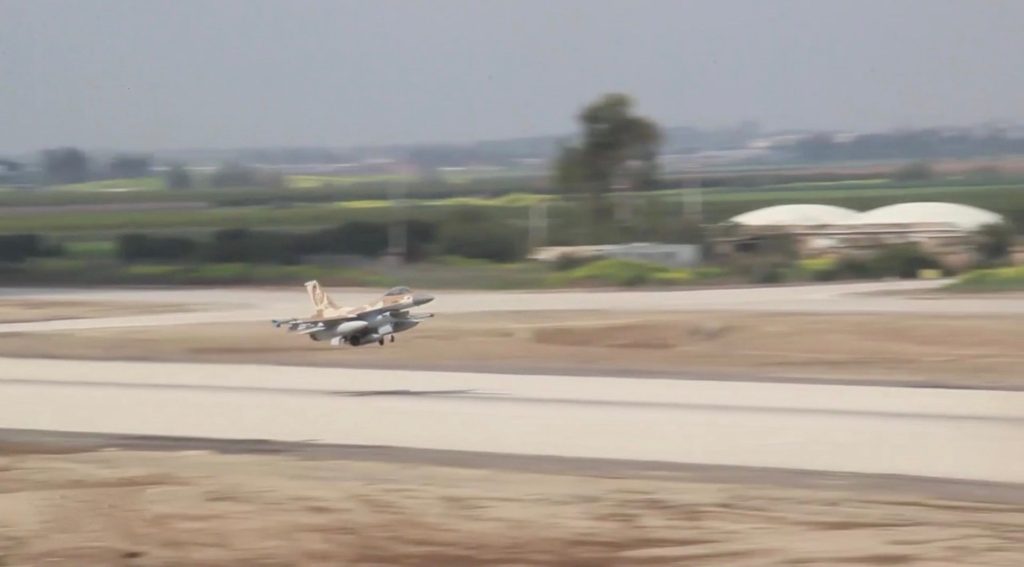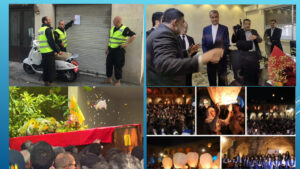[vc_row][vc_column][vc_column_text][/vc_column_text][/vc_column][/vc_row][vc_row][vc_column][vc_column_text]Nowadays, The IDF Northern corps, are exercising a 10 day’s mock war against Hezbollah in light of the growing Iranian influence in Syria and Lebanon, close to the border with Israel- it is one of the greatest exercises that IDF have ever conducted. Tens thousands of soldiers, in service and reserve, from all main forces of IDF, are participating the drill1. In contrast to previous exercises the state of Israel published many details about the mock war and the possible modes of action in a future war, as a deterrence method. Military officials stated that the drill was planned during the last year, with the purpose of strengthening IDF`s abilities and deterrence facing the Shi’ite organization, and not with a purpose of an initiated military deployment towards a war in the near future.
Maj. Gen. (res.) Amir Eshel, who recently completed his service as commander of the Israeli Air Force, provided some important insights about the IAF’s activities and capabilities, in light of recent intelligence analysis coming out of Lebanon, Syria, and other countries in the region. Eshel’s statements may sound somewhat hostile or even brutal, but in fact, he is using an effective and legitimate deterrence tool against the aggressive escalation in the ever-challenging Middle East neighborhood — where the rule is: if you are not strong enough, you cannot possibly survive.
It’s an ‘open secret’ that the IDF attacked convoys of weapons intended for Hezbollah and other terror-groups in recent years. Maj. Gen. Eshel revealed for the first time that over the past five years, in order to prevent the smuggling of sophisticated weapons to terrorist, Israel had attacked these convoys almost 100 times. Eshel told the Ha’aretz2 newspaper that “An action could be an isolated thing – small and pinpointed, or it could be an intense week, involving a great many elements. Happily, this goes ‘under the radar’… We had the good sense not to drag the State of Israel into wars.”
On Friday evening3 August 18th,Eshel, still wearing his IAF uniform at his farewell interview with Israeli television’s Channel 2, talked about the IAF’s intelligence abilities and strategic targets in the context of changes around the Middle East. Eshel said: “The Israeli Air Force is not only an enormous power, but a huge and mighty hammer. In the ever-changing Middle East, we are positioned where we want to be. We are like a scalpel that surgically removes the threat and proceeds onward. We are world leaders in attack capabilities and the IAF can hit thousands of targets in any one day.”
Regarding a future conflict with Hezbollah, Eshel warned: “I cannot guarantee that there will be no war with Lebanon. We can fend off any potential war at this time because our enemies understand that we know more than they can imagine about them. The State of Israel is determined to enforce its security interests and any future war in Lebanon will be very different. If and when the IAF operates in Lebanon, the war will be felt by that entire country at the same time: … in the capital Beirut, in the Beqaa Valley (adjacent to the Syrian border) as well as in the south – simultaneously. We intend to operate intensively against the terror infrastructures from the first moment. An IAF warplane is able to attack 20 targets at the same time, with only one push of a button. We can’t afford to wake up one morning and say ‘we aren’t ready enough,’ especially with our Air Force — the fastest, the deadliest, flexible, and immediate force we have.”
Eshel added that “the attack methods and abilities we have developed, together with our intelligence capabilities, can generate a highly effective and powerful pre-emptive strike option.”
Some of the intelligence Eshel may implied to was published simultaneously: reports in Israel showed satellite images4 of a missile factory in Syria, near the city of Baniyas, south of the coastal city of Latakia. According to the reports, the Syrian factory will produce and store long-range Scud missiles, with a range of almost 700 kilometers, able to cover most of the State of Israel. This factory is expected to be ready for production by the end of 2017. Senior intelligence experts said that the buildings at the Syrian site are very similar to buildings in Tehran, Iran. This fact indicates Syrian cooperation with Iran, that is well known as Bashar Assad’s close and loyal supporter.
Later on, prime minister Netanyahu approved this, and during his meeting with the UN secretary general, he said: “It (Iran) is also building sites to produce precision guided missiles in both Syria and Lebanon. That is something Israel cannot accept”.
Moreover, a French intelligence on-line magazine reported that two underground missile factories are being built in Lebanon. One of them is located near Hermel, in the eastern Beqaa Valley. This factory will produce a medium-range missile resembling the “Fateh-110,” with a range of 300 kilometers (190 miles) carrying a half-ton warhead. The second factory is being built on the southern coast between the Lebanese cities of Sidon and Tyre. This facility will be used for manufacturing smaller munitions. The factories in Lebanon will increase the accuracy of Hezbollah rockets targeting Israel and will be able to upgrade older rockets that Hezbollah is currently holding in Lebanon.
As for the new underground tunnel-threats, Eshel explained the reasons for using heavy bombs and emphasized that they are only “one tool Israel can use out of its tool box. There are targets that only heavy bombs can deal with. They can reach underground tunnels tens of meters below the surface, and they can completely destroy buildings.”
Why is everything happening now? First of all, the recent intelligence reports – along with Eshel’s statements – were published while Lebanon was celebrating the end of the 33-days war against Israel in 2006 and Hezbollah was staging military celebrations in the streets. Every summer since then, both sides have exchanged messages of warning and intimidation. Second, Hezbollah and its Shi’ite allies seem to be winning their battles in Syria with the assistance, and under the influence of Russia. As a result, Hezbollah has become emboldened and is far more confident about its military capability. Provocations, including open violations of the UN Security Council resolution, are taking place every day along Israel’s northern border.
The purpose of Eshel’s recent aggressive deterrent messages is actually meant to prevent potential escalation between Hezbollah and Israel. He exposed Israel’s military cards to its enemies for a purpose: to demonstrate that Israel is very determined to prevent the empowerment of terrorist groups and it will take any and all steps necessary to ensure its security for the challenging decades ahead.
Links:
[/vc_column_text][/vc_column][/vc_row]






